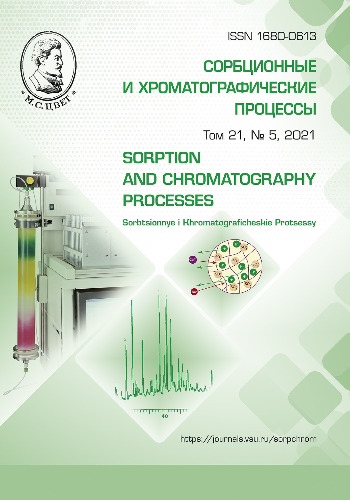Tealike beverages: chemical composition, antioxidant activity, and effect on human health
Abstract
The article reviews the existing literature on the most popular tealike beverages (fireweed tea, mate, hibiscus tea, rooibos tea), their chemical composition, antioxidant activity, and effect on human health. The chemical composition is most often determined by HPLC and UHPLC with various extraction techniques. All tealike beverages contain polyphenols-antioxidants: flavonoids (quercetin, kaempferol, myricetin, rutin, and their glycosides) and phenolic acids (gallic acid, ferulic acid, caffeic acid, chlorogenic acid, protocatechuic acid), and anthocyanins (delfidine and cyanidin). The antioxidant activity was assessed using well-known methods (ORAC, ABTS, DDPH). Due to their high antioxidant activity these drinks have a health-improving effect and can even inhibit the development of serious diseases such as cardiovascular, oncological, and viral diseases. In our study, we measured their antioxidant activity using the amperometric method and compared it to the antioxidant activity of green and black teas from various countries. Using HPLC with an amperometric detector, we obtained specific chromatograms in identical conditions, which can be used to compare the beverages. The total area of all the chromatographic peaks registered by the amperometric detector can be a measure of antioxidant activity, i.e. the amperometric detector selectively registers antioxidants only and does not identify non-antioxidants. The highest antioxidant activity was registered in mate and fireweed tea.
The article also gives a brief overview of other less popular tealike drinks, such as kuding, taheebo, Tibetan butter tea, buckwheat tea, Dasiphora tea, cannabis tea, artichoke tea, touareg tea, Chang Chu tea, Himalayan tea, etc. A lot of countries have their own national tealike beverages composed of herbs. A large variety of herbal and fruit beverages are on sale. We should also note that manufacturers often add various herbs and fruit, such as jasmine, bergamot, etc., to tea. The purpose of this brief overview is to acquaint the readers with the published information about these drinks. The authors hope that a large number of readers will find this information useful and will use it to choose tealike drinks meeting their personal requirements.
Downloads
References
Korsun V.F., Viktorov V.K. et al., Russkij Ivan-chaj, M., Artes, 2013, 140 p.
Czarev V.N., Bazarnova N.G., Dubenskij M.M., Khimiya rastitel`nogo syr`ya, 2016, No 4, pp. 15-26.
Kuklina T.P., Frolova T.S., Sal`nikova O.I., Khimiya rastitelnogo syrya, 2014, No 1, pp. 139-146.
Bushueva G.R., Sy`roeshkin A.V., Maksimova T.V., Skal`ny`j A.V., Mikroe`lementy` v mediczine, 2016, Vol. 17, pp. 15-23.
Zabelkin N.A., Ulanova N.G., Ivan-chaj uzkolistny`j v sb. «Biologicheskaya flo-ra Moskovskoj oblasti», M., Izd-vo «Argus», 1995. Is. 11, pp. 166-191.
Zajczev V.N., Ivan-chaj. Zashhitnik ot 100 boleznej, M., Ripol klassik, 2013, 192 p.
Bastos D.H.M., Fornari A.C., Queiroz Y.S. et al., Acta Farm. Bonaerenge, 2005, Vol. 24, pp. 91-95.
Bastos D.H.M., Saldanha L.A., Cath-arino R.R. et al., Molecules, 2007, Vol. 12, pp. 423-432.
Bravo L., Goya L., Lecumberri E., Food Res. Int., 2007, Vol. 40, pp. 393-405.
Cardozo E.L., Ferrarese Filho O., Cardozo Filho L. et al., J. Food Comp. Anal., 2007, Vol. 20, pp. 553-558.
Dartora N., Souza L.M., Santana-Filho A.P. et al., Food Chem., 2011, Vol. 129, pp. 1453-1461.
Filip R., Lopez P., Gilbert G et al., Fitoterapia, 2001, Vol. 72, pp. 774-778.
Filip R., Lotito S.B., Ferraro G., Fraga C.G., Nutr. Res., 2000, Vol. 20, pp. 1437-1446.
Bastos D.H.M., Ishimoto E.Y., Marques M.O.M. et al., J. Food Comp. Anal., 2006, Vol. 19, pp. 538-543.
Heck C.I., Schmalko M., Mejia E.G., J. Food Sci., 2007, Vol. 72, pp. R138-R151.
Isolabella S., Cogoi L., Lopez P. et al., Food Chem., 2010, Vol. 122, pp. 695-699.
Mazzafera P., Food Chem, 1997, Vol. 60, pp. 67-71.
Turner S., Cogoi L., Isolabella S. et al., Adv. J. Food Sci. Technol., 2011, Vol. 3, pp. 23-30.
Da-Costa-Rocha I., Bonnlaender B. et al., Food Chem., 2014, Vol. 165, pp.424-443.
Tsai P.J., Mclntosh J., Pierce P. et al., Food Research. Intern., 2002, Vol. 35, pp. 351-356.
Frank T., Netzel G., Kammerer D.R. et al., J.Sci.Food Agric, 2012, Vol. 92, pp. 2207-2218.
Hopkins A.L., Lamm M.C., Funk J.L., Ritenbaugh C., Fitoteraphia, 2013, Vol. 85, pp. 84-94.
Wahabi H.A., Alansary L.A., Al-Sabban A.H. et al., Phytomedicine, 2010, Vol. 17, pp. 83-86.
McKay D.L., Chen C.Y., Saltzman E., Blumberg J.B., J. Nutrition., 2010, Vol.140, pp. 298-303.
Lin H.H., Chan K.C., Shen J.V. et al., Food Chem., 2012, Vol. 132, pp. 880-891.
Linn H.H., Huang H.P., Huang C.C. et al., Molecular Carcinogenesis, 2005, Vol. 43, pp. 86-99.
Lin T.L., Lin H.H., Chen C.C. et al., Nutr. Res., 2007, Vol. 27, pp. 140-145.
Okoro E.C., Nigerian Food J., 2007, Vol. 25, pp. 158-164.
Beelders T., Kalili K.M., Joubert E et al., J. Sep. Sci., 2012, Vol. 35, pp. 1808-1820.
Beelders T., Sigge G.O., Joubert E. et al., J.Chrom. A, 2012, Vol. 1219, pp.118-139.
Bramati L., Aquilano F., Pietta P., J.Agric. Food Chem., 2003, Vol. 51, pp. 7472-7474.
Iswaldi I., Arraez-Roman D., Rodri-guez-Medina I. et al., Anal. Bioanal. Chem., 2011, Vol. 400, pp. 3643-3654.
Joubert E., Food Chem., 1995, Vol. 55, pp. 403-411.
Joubert E., de Beer D., J. Food Comp. Anal., 2012, Vol. 27, pp. 45-51.
Joubert E., Schulz H., J. Appl. Bot. Food Qual., 2006, Vol. 80, pp. 138-144.
von Gadow A., Joubert E., Hansmann C.F., Food Chem., 1997, Vol. 60, pp. 73-77.
Krafczyk N., Glomb M.A., J. Agric Food Chem., 2008, Vol. 56, pp. 3368-3376.
Yashin A.Ya., Yashin Ya.I., Cher-nousova N.I., Pishhevaya promy`shlennost, 2006, No 2, pp. 10-13.
Yashin A.Ya., Analitika, 2020, No 3, pp. 1-8.
Yashin A.Ya., Sorbtsionnye i khromatograficheskie prozessy, 2020, Vol. 20, No 2, pp. 158-165. https://doi.org/10.17308/sorpchrom.2020.20/2770







